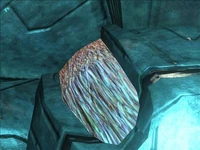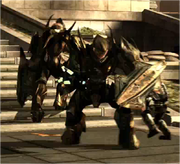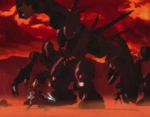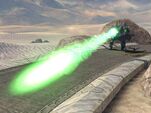青の装甲に身を包んだエイリアン。初代HALOからの登場。 人型に見えるが、本来は体長1.4mのミミズ状の生物(レクゴロ)である。
本来彼らの故郷であるはずの惑星テー外部で目撃されることが多く、目的に合わせた複合体(ムガ レクゴロ)を形成し総合的な知性と能力を高めている。
レクゴロが有機的に合体すると、ハンター(ムガ レクゴロ)になる。
装甲はコヴナントの金属の中でも未知の金属で、その耐久力は非常に高い。 コヴナントの中では最大の種族で、身長は3mを優に超える。出現する時は必ず二体ペアである。 装甲は頑強で、たとえ背後からであっても攻撃は通用しない。 弱点は背部や腹部の装甲が無い部分で、頭部に見える部分ではない。 主武器は右腕に内蔵された燃料式ロッドガン。これにより対車両戦でも遺憾なく戦える。 また、盾によって接近戦もこなす。 実力を認めたエリート族以外の種族とは交流を持たず、HALO2のエリート族コヴナント脱退に伴い、 ハンター族の多くが人類と敵対しなくなった。 ハンター族の母星であるテーは鉱物資源に恵まれており、これを狙ったコヴナントがテーに侵攻、戦争が勃発した。 そして旧アービター、エリートの活躍により和解。鉱物資源を提供する代わりに、遅れていた惑星間航行技術を提供してもらっている。 コヴナントでの立場は重要で、要所の警護及び敵重要地点の襲撃を担当している。
Background[]
784 B.C.E.彼らの故郷テーが、鉱物資源の豊富さゆえ、コヴナントによって侵略された際、ハンターは激しく抵抗した。 この戦いでコヴナントの侵攻は一時停止、旧アービターが殺害される。その生理学的特性は岩に囲まれた過酷な環境において、戦術的利点を与えたようだ。 コヴナントは、サンヘイリの猛攻にも関わらず苦戦。 軌道上の砲爆撃に依存することを余儀なくされる。
ハンター自身を絶滅から救うための唯一の選択は、コヴナントに参加することであった。 意思の疎通が困難であったが、和解。 コヴナントに参加するそれらの協定においてハンターは、ハイチャリティにあったフォアランナードレッドノートを調査し、その内部の働きを研究する為に委託された。
ムガレクゴロの単一のコロニーが大きくなりすぎると、コロニーは半分に分かれて2つの独立したムガレクゴロコロニーを作成します。これらの植民地は、「絆の兄弟」または「仲間」としてのみ呼ばれる、非常に親密で神秘的な絆を共有します。ガレクゴロが使用した装甲と突撃砲は、前者が契約に加わった後、サンヘイリから与えられた。「絆の兄弟」に分かれたムガレクゴロは、肩から立ち上がるスパイク状の付属物によって認識され、別のムガレクゴロと結びついていることを意味します。 拘束されたムガレクゴロの植民地は、スパルタ人が学んだように、契約によって一緒に戦いに落とされます:あなたがムガレクゴロを見つけるところには、常に近くに別のものがあります。結合したコロニーの一方が殺されると、もう一方はジラルハナエのベルセルク状態やアンゴイの自殺罪に似た狂気の状態になります。しかし、長期間放っておくと、射撃に続いて近接攻撃を行う「分裂した性格」を採用します。
オニキスの戦いの間、一部のムガレクゴロは明らかに下位のサンヘイリの指揮を執っており、コヴナント軍では以前に示されたよりも高い軍事ランクを持っている可能性があることを示している。
Description[]
A Mgalekgolo as seen in Halo: Combat Evolved.
Hunters take the hulking bipedal form in the Covenant military.[1] In this form, they are the strongest and most resilient species in the Covenant [2]. They usually stand between twelve to thirteen feet tall, but when in their combat state they crouch into between eight to eight-and-one-half feet, protecting their visible, unarmored stomach and neck. Though uncommon, the Mgalekgolo can even come in larger sizes and even bigger than the standard Covenant Wraith. Their political motivation is completely unknown.[3] Their armor has a blue luster that makes the orange-red skin of the Lekgolo worms inside very noticeable, but the colony itself is hard to spot. They always fight in pairs due to the fact that when the colony gets too big, it splits into another Mgalekgolo form, creating a powerful bond between the two bond brothers.
Hunters fight using Assault Cannons integrated directly into their armor, and they carry an enormous, and nearly impervious metal shield made of an unknown alloy derived from the same material that forms Covenant warship hulls, and weighing approximately two tons. This shield protects them from almost every form of plasma-based or ballistic weaponry available to Covenant and human infantry alike, and is a powerful melee tool capable of crushing anything in its path and allowing the Mgalekgolo to sweep away most enemies in close combat. The Hunter can also gain a surprising burst of speed when it moves in for a melee kill.
The Assault Cannon the Hunter wields operates in two modes; one firing a single explosive capsule of incendiary fluid[4], the other spraying the fluid out like a beam.[5][6] The beam is more devastating than the single explosive shot, because this attack lasts longer and so wide spread damage can be done to more than just one enemy, or a single enemy can be badly injured or even killed.
Anatomy and Physiology[]

A Mgalekgolo fighting in a Forerunner structure on the Halo 3 level, "The Covenant".

Lekgolo worms inside a Scarab shell.
- Main Article: Lekgolo
Hunters are not a single organism, but rather are composed of multiple small, orange, eel-like beings called Lekgolo, that form a single collective consciousness and act as one, a single "hive-mind", similar to the structure of operation in the Flood. In other words they are a communal organism working together to perform specific tasks. Mgalekgolo are capable of manifesting in several different iterations according to what goal they are striving to achieve and the amount of Lekgolo worms that are present. The Mgalekgolo is the most common form seen in combat during the Human-Covenant War, but is actually one of the more rare forms in the Lekgolo society. This Mgalekgolo is employed by the Covenant as heavy infantry. Their society is predominated by this combination of being able to create exponentially more intelligent creatures, and the actual "Hunter" organism is one of the rarer and smaller forms to be found, used primarily in interaction with the Covenant hierarchy. Because of their make-up of several hundred "eels" instead of being a single large organism, the Lekgolo are one of the only species in the Covenant that cannot be assimilated by the Flood, as their unique physiology does not allow the organism to access a central nervous system or control them to any capacity. As such, there has never been a Hunter Combat Form, though the flesh of the Lekgolo can most likely be used by the Flood simply for its biomass.
The collection of eels that make up a Hunter's body are unintelligent at the most basic level, but can form complex thoughts and emerge as a conscious individual when they combine into larger masses that communicate through chemical and electrical means. The neural net that Hunters develop enables them to be incredibly strong and very sensitive to all things within a 1,000 foot line pointing out from non-combat form, and a half sphere that extends 500 feet in combat form[verification needed]. This could explain why Hunters sometimes can locate the Master Chief even when they cannot see him, or when they are facing the opposite direction. This also explains why Hunters can think and work as an effective combat unit without even using verbal communication. Hunters generally growl during battle but will sometimes talk and make remarks like the other Covenant species. Instead of using vocal chords, like other Covenant species, they vibrate their bodies to make a low rumble that is described as "more felt than heard" to produce speech.[7]
It is theorized that Hunters reproduce asexually similar to earthworms; however there is no way to be certain. If true, calling Hunter pairs "mates" would only make sense in term for the pairing of two, not actually mating.
Communication[]
ほとんどのハンターの言語について知られていません。
何人かのハンターの既知の名前は、英語のアルファベットの中に含まれているように、彼らがほとんど多くとしてでなく非常に簡単な母音とほとんどない子音?を使うことを暗示するようです。
ハンターが、話すために声帯を使わないことは知られています; 代わりに、彼らは、音を生み出すためにそれらの体の中でレクゴロを振動させるようです。
コヴナントの他の種族はハンターの静寂主義的な性質のため、他のコヴナント種族とコミュニケーションが難しく、他のコヴナント種族に忍耐を要する問題を招いています。
ハンターの声はヘイローゲームのすべてにおいて聞くことができて、シリーズを通して全くと言っていいほど変更がありませんでした。
ハンターは敵を発見する時、または傷つけられると、非常に深く、低くごろごろ鳴る音を立てる傾向があります。
死ぬ時に、彼らは、低い悲鳴を放つようです。
彼らはまた、殺した後にくすくす笑うようです。 それは別として、かろうじて、ハンターは話します。
しかし、それらは、亜音速の振動を経た他の種の言語、話す言葉、および、文章で他の種の言語をまねすることが可能です[7][8]
Culture[]
Mgalekgolo almost never associate or even communicate with the other races in the Covenant Empire. Sangheili are the sole exception; Hunters appreciate and acknowledge the Elites' warrior thoughts and adeptness in combat. To the other races of the Covenant, however, the Hunters are dismissive, scornful, and arrogant, and they are utterly contemptuous of their foes. Hunters have no qualms about committing friendly fire against the "lesser" races, like Unggoy and Kig-yar; during the Battle of Sigma Octanus IV, a Hunter was seen running over and killing a Jackal. In Halo 3: ODST, Hunters will attack foes regardless of any allies that happen to be in their line of fire, as demonstrated in the game's final Campaign mission.
Many members of the Covenant are mystified and confused by the Mgalekgolo; their way of life is almost as alien to the Covenant as that of the Flood. A Sangheili Fleet Master once noted that Hunters were known to tear opponents apart with their "bare hands" whilst in a blood frenzy, and then suddenly pause to recite war poetry.[9] It has also been said that Hunters meditate in their spare time, or before battle.
During the Covenant Civil War, most Hunter pairs sided with the Sangheili and the Covenant Separatists, though others remained with the Prophet of Truth and the Covenant Loyalists. There is no known reason for the split in loyalty. It is likely that the Separatist Hunters split from the Covenant due to their respect for the Elites. It is likely that the Loyalist Hunters remained in the Covenant out of fear for their homeworld; the Hunters were integrated into the Covenant during the Taming of the Mgalekgolo, when the Covenant threatened to glass their homeworld.
No Hunters are ever seen supporting the Master Chief during the events of Halo 3. This is because in the making of Halo 3, Bungie did not want to confuse players by having them with both the Separatists and the Loyalists, so they were only shown as Loyalists.
Naming[]
Hunters have three names: a personal name, a bond name, and a line name. The personal name is given at their "birth". The line name represents the genetic heritage, being the name of the most successful Mgalekgolo of his ancestors. If one reaches a certain level of status, his offspring will have his personal name as their line name. The bond name, or their middle name, is taken between bonded pairs, colonies that must split into two due to excessive size. Examples of some Hunter names include Igido Nosa Hurru and Ogada Nosa Fasu. From the few Hunter names that have appeared in the novels, it seems that the given name has three syllables, but the bond name and line name only have two syllables. This may be another 7 reference, as 3 + 2 + 2 = 7.
However, it is not known why the line name is not three syllables, considering that the ancestor in question's given name would be three syllables. It is most likely not always three syllables or the name is edited (a syllable is possibly taken away) before the offspring is given the line name.
Religion[]
All that can be said for certain about Mgalekgolo religious beliefs is that they vary. While the Lekgolo joined the Covenant for its access to space trade routes and starships, rather than any real dedication to the Great Journey, at least some hold a concept of an "afterlife".[10][11] Other Lekgolo meditate in their spare time, or recite war poetry before or after battle, showing a more refined nature than would be believed of the hulking, savage warriors.[12] The fact that some allied themselves with the Sangheili during the Great Schism, while others remained with the Covenant Loyalists, is further evidence that individual beliefs play a major part in Mgalekgolo religion.[6] Anything further than this is speculation, Lekgolo culture is extremely reclusive, and even their fellow Covenant know little about them other than that they continue to follow their own cultural traditions, rather than the homogenized religion of the wider Covenant.[13]
Ranking System[]

A pair of Gold Mgalekgolo in Halo 3: ODST.
Unlike other Covenant forces, Hunters seem to possess no visible rank. They are deployed as support troops rather than as baseline soldiers, which may therefore indicate that a rank is unnecessary as they are used as equipment rather than soldiers. They seem to be of a low rank, but only take commands from Prophets or Elites.
However, they can be deployed independently of other Covenant troops, which may indicate that a level of independence and responsibility may be granted, thus meaning that they may have a high enough rank to be trusted by themselves. In Halo: The Fall of Reach, Mgalekgolo are seen guarding the crystal in Cote d'Azur, which is retrieved by Blue Team. As they are guarding such a highly valued target, they may be of a higher rank than other Hunter pairs. Also they killed a Jackal by stepping on it, which may show that they are higher in rank than the Jackals, although it is more likely that the Hunters merely did not care about the other alien's life.
In Halo 3: ODST, the Hunters appear in two different forms in two different colors; the normal blue-armored Hunter, which are identical to the ones seen in Halo 3, armed with an Assault Cannon that fires a continuous stream of radioactive incendiary gel and a gold-armored Hunter, armed with an assault cannon that fires a single bolt of radioactive incendiary gel which is similar to the weapon model featured in Halo: Combat Evolved. Gold-armored Hunters were said by Bungie to be leader Hunters.
In addition, in Halo: Contact Harvest, a third rank of Hunters with silver clad armour is said to be guarding the Forerunner Dreadnought in High Charity.
Gameplay[]
Not many traditional weapons work well on the hunters, Assault Rifles and Battle Rifles only work if you can sneak behind them, but if you get close enough melee to the unarmored orange section is best, even though none of these methods are 1-hit kills. If you try to sneak behind it, be careful, because as soon as it realizes you're behind it, then it will give you a good whack with its shield. Long range weaponry and vehicles don't work well, because of the hunters' fuel rod cannon (Sniper Rifles or Beam Rifles don't work well otherwise in the front because of the shield for the most part). Scorpions are the exception (excluding Halo Wars) and so are most explosives. Two Fuel Rod Cannons or Rocket Launchers to any part of the body (besides the shield, obviously) will take down a Hunter. trying to take down a hunter by shooting him in the back is a last resort as Hunters travel in pairs of two, leaving the second Hunter an open shot at you. Another tactic against hunters consists of getting close to them and when the Hunter starts to chase you to hit you with it shields, you begin to fall back, all of this while firing continually with an Assault Rifle or Battle Rifle (obviusly not firing at the shield if you can). This tactic only works in closed areas and it requires a lot of bullets to kill a hunter (aproximately 90 rounds) if you don't hit the orange zone. But if you're skilled enough to avoid get cornered, the hunter will never hit you and you will save ammo from more valious and rare weapons such a Plasma Rifle, Sniper Rifle or Rocket Launcher
Trivia[]
- In Halo: The Flood, it mentions that Hunters have skin and a jutting spine. This is incorrect, as they were revealed to be a compound of small worm-like creatures. However, this does not preclude the possibility that the worms may form a skin-like membrane on the outside of their colony for protection against more casual damage, and in Halo 3 a metal column can be seen after the back armor plating has been detached, perhaps forming an artificial "spine" for vertical support.
- At first, Hunters were meant to comprise the whole of Heretic forces on the Gas Mine.[14]
- In a Bungie Weekly Update, Frank O'Connor said: "Hunter society is complex and we have seen but the tiniest fraction of it. There are some fundamental facts about Hunter biology that mean the combat type is just the tip of the iceberg."[15] This means, or at least implies, that there are other kinds of Hunters that simply have yet to be seen. For example, Scarabs are powered by these worms.
- SPARTAN-II William-043 killed a Hunter by ripping out some of the Lekgolo worms in its body, showing that a Hunter can be killed if too many of its worms are displaced.
- It is possible to splatter a Hunter with a Mongoose.
- In Halo Wars, a Hunter can deflect many projectiles that would kill them in Halo 3, for example a Wraith Mortar or a Scorpion main cannon shot.
- The Hunter resembles the enemy of the same name from Bungie's older series, Marathon, except that Marathon's Hunter has a shoulder-mounted weapon, rather than an arm-mounted weapon.
- Hunters can be killed by berserking Brutes, as noticed in the Halo 2 levels Gravemind and The Great Journey. The Covenant Separatist Hunters would try to melee the Loyalist Brutes away, but the Brutes, having a faster melee attack, would continuously melee the Hunters, eventually killing them.
- Hunters can range in size from a Spartan to nearly eighteen feet tall.
- Hunters in Halo: Combat Evolved are not harmed by Fuel Rod Guns. This may be because you are not supposed to have Fuel Rod cannons in Campaign, or it may be a precaution meant to prevent Hunters from injuring each other when fighting in pairs.
- Hunters in Halo: Combat Evolved have ranks in the actor variant tags. One variant is called 'Hunter' and another called 'Hunter major'. In Halo 2, there is no ranking system for Hunters.[citation needed]
- Like most other races of the Covenant, Hunters' blood differs from that of humans. Mgalekgolo blood is bright, fluorescent orange and appears to have a very thick, slimy texture. It has also been noted that their blood smells strongly of burnt plastic, hinting that the make-up of their bodily fluids is drastically different from that of a human.
- In Halo: First Strike, it was stated that the spikes on the Hunter's back are sensory nodes.[16] Additionally, the spikes on Hunters' backs were said to be as sharp as razors in Halo: The Flood.
- In Halo Legends' episode The Duel, the Hunters are shown to be at least 50 feet tall, this was later explained by Frank O'Connor saying that a Hunter's appearance changes due to the gravity and environment.
- In Halo Reach hunters have recieved a huge graphical overhaul. They are much more textured, appear to be larger,have Forerunner symbols and emblems on their armour and appear to have some kind of eyes on their helmets.
- In Halo: Combat Evolved, a single shot from a pistol or sniper rifle will kill a Hunter; this is likely because the Hunter's exposed flesh was considered to be its "head."
- Hunters are the only covenant units who cannot be killed with a melee to the back.
Gallery[]
Sources[]
- ↑ Bestiarum
- ↑ Halo 3 Game Guide, http://www.microsoft.com/silverlight/halo3.aspx, On Covenant character page.
- ↑ Halo Legends: The Duel
- ↑ Halo: Combat Evolved
- ↑ Halo 2
- ↑ 6.0 6.1 Halo 3
- ↑ 7.0 7.1 Halo: Ghosts of Onyx, pages 190-191
- ↑ Halo 3: ODST Field Guide
- ↑ Ghosts of Onyx
- ↑ 引用エラー: 無効な
<ref>タグです。「Bestiarum」という名前の注釈に対するテキストが指定されていません - ↑ Halo: The Flood
- ↑ Halo: Ghosts of Onyx
- ↑ The Covenant Primer: Best of The Bestiary
- ↑ "Essentials - Disk Three"
- ↑ http://www.bungie.net/News/TopStory.aspx?story=updatefeb03
- ↑ Halo: First Strike, page 110
Related Pages[]
- Hunters in the Games
- ハンターの順化
- Assault Cannon
- Scarab
- Lekgolo
テンプレート:Covenant







